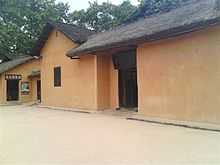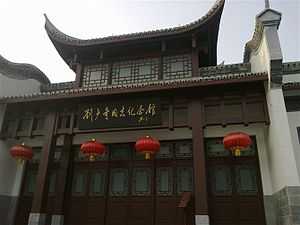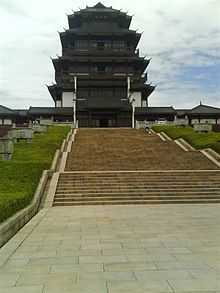Liu Shaoqi's Former Residence

The Liu Shaoqi's Former Residence (simplified Chinese: 刘少奇故居; traditional Chinese: 劉少奇故居; pinyin: Liú Shàoqí Gùjū) was built in the late Qing Dynasty, it is located in Huaminglou Town of Ningxiang County, Hunan Province, in the People's Republic of China. It has an area of about 4,000,000 square meters and a building area of about 20,000 square meters, embodies buildings such as the old houses (故居老屋), the Liu Shaoqi Memorial Hall (刘少奇纪念馆), the statue of Liu Shaoqi (刘少奇铜像), the Cultural relics Exhibition Hall (文物展览馆).
History

In 1796, in the first year of the age of the Jiaqing Emperor (清朝嘉庆元年), it was built by Liu Shaoqi's forebear.[1]
In 1898, Liu Shaoqi was born in here.[1]
On its opening late in 1959, it was listed as a "Historical and Cultural Sites Protected at the Provincial Level" (省级重点文物保护单位).[1]
In May 1961, Liu Shaoqi and his wife Wang Guangmei returned to Hunan and they lived here. During the Great Leap Forward, Liu Shaoqi handed out their own daily necessities to farmers.
In 1966, during the Cultural Revolution, the house was broken down by the Red Guards (红卫兵) and the cultural relics were stolen.[1] On October 1, 1966, the site was closed.[1]

In February 1980, Liu Shaoqi was rehabilitated. The People's Government of Hunan Province and the People's Government of Ningxiang County rebuilt the house.[1] On March 5, it was opened to the public again.[1]
In 1982,Deng Xiaoping wrote "Liu Shao-qi's Former Residence" on the horizontal tablet.[1]
In January 1988, it was listed as a "Major Historical and Cultural Site Protected at the National Level" (全国重点文物保护单位) by the State Council of China.[1]
References
| Wikimedia Commons has media related to Liu Shaoqi's Former Residence. |
Coordinates: 28°01′56″N 112°38′44″E / 28.032175°N 112.645609°E